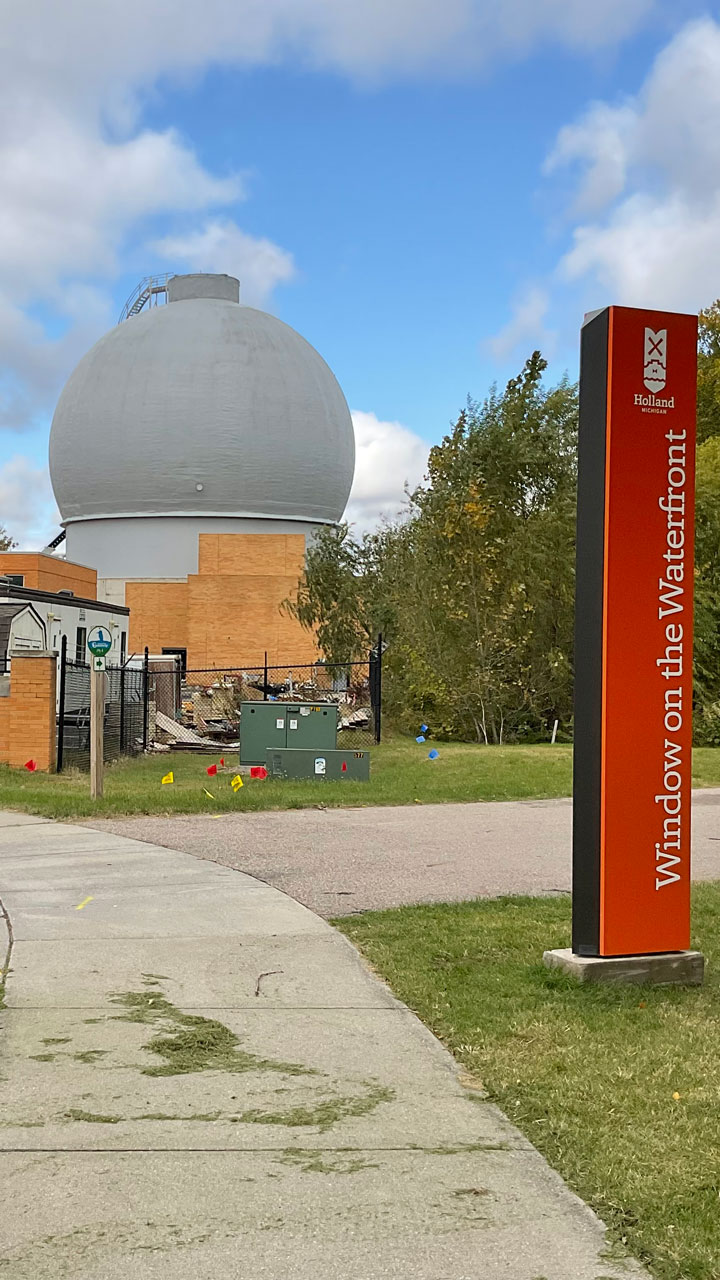ENVISION Gold Anaerobic Digester
Infrastructure is everywhere: underground, overhead, and all around. As Holland’s community-owned utility, infrastructure maintenance and development is a core function of Holland BPW. Maintaining and scaling Holland’s utility systems is essential to the well-being and prosperity of our community.
Although infrastructure is everywhere, it often goes unnoticed. But in Downtown Holland, there is an interesting structure at the Water Reclamation Facility (WRF) that stands out. It is a 105-foot-tall, two-million-gallon tank painted in a subtle gray color, coined Macatawa Mist, to help it blend with its surroundings. The structure is called an anaerobic digester. Shaped like an egg, it uses anaerobic microorganisms (organisms that don’t require oxygen) to process solids that are separated from our community’s wastewater during the water reclamation process. These microorganisms are the same healthy microbes inside our bodies that digest food.

Anaerobic digestion is a sustainable process that reduces the volume of the solids while also producing methane gas. Methane is a renewable fuel source that can be used to generate heat and power for usage at the WRF. Biosolids are the other byproduct of anaerobic digestion. The anaerobic digester is expected to produce U.S. Environmental Protection Agency (EPA) Class A biosolids. Meeting that standard allows for unrestricted beneficial reuse of the biosolids as a fertilizer and soil amendment due to the treatment the material receives.
“Biosolids are the nutrient-rich organic materials resulting from the treatment of domestic sewage in a wastewater treatment facility. Biosolids are a beneficial resource, containing essential plant nutrients and organic matter, and are recycled as a fertilizer and soil amendment. When treated and processed, these residuals can be recycled and applied as fertilizer to improve and maintain productive soils and stimulate plant growth,” (EGLE).

Why is the anaerobic digester needed?
The anaerobic digester is an important addition to the water reclamation process. “Options for disposing of biosolids are increasingly difficult to find and the costs are rising. Anaerobic digestion allows us to address these challenges sustainably,” said Joel Davenport, Holland BPW Director of Operations. We expect this new process to reduce the amount of wastewater solids from the water reclamation process by approximately 50%. The anaerobic digester increases the efficiency of water reclamation in a variety of ways, including solids reduction, biogas production, treating solids to a higher end-use product, and providing an opportunity to generate heat and power on-site using the methane collected.
Building the multi-year project of the anaerobic digester began with research to determine the best solution to solid disposal challenges. The complete design, engineering, and construction of the digester took about three years and is expected to finish under budget, with a total cost of less than $33M. The project was awarded special low-interest funding through the Clean Water State Revolving Fund (CWSRF) administered by the Michigan Department of Environment, Great Lakes and Energy (EGLE). Due to the sustainable nature of the project, it also qualified for a grant of $6 million through the CWSRF’s Green Project Reserve (GPR). This grant significantly lowered the financial investment required for this sustainable infrastructure project.
ENVISION Gold
In February 2023, the anaerobic digester received an ENVISION Gold rating for sustainability. ENVISION is a third-party verification and recognition program developed and managed by the Institute for Sustainable Infrastructure (ISI). The ENVISION framework encourages systemic changes in the planning, design, and delivery of infrastructure projects to ensure that they are sustainable and resilient, maximizing the benefits to the community. “ENVISION goes beyond the basic efforts of project management and development, into areas that holistically benefit the community,” explained Dave Koster, Holland BPW General Manager. “Our goal is to bring as much value to those impacted by the project as possible.”
“We are excited to announce that the Holland Area WRF Anaerobic Digester project has won an Envision Gold Award for sustainable infrastructure,” said Melissa Peneycad, ISI’s managing director. “Holland BPW and the project partners engaged with the community to ensure its needs and goals were understood and incorporated to the greatest extent possible, and the result is a transformative development for sustainability at the Holland Area WRF that will benefit the community for many years to come. Congratulations to the entire project team on the success of this project.”


The primary scope of the project is the anaerobic digester facility, but there are additional process improvements and modifications that contributed to the ENVISION Award: the biogas utilization system; the recycle stream treatment process (with post-aerobic digester for ammonia removal); the biosolids thickening systems; odor control measures; and related site improvements.
Holland BPW values the Envision framework because the criteria for evaluation are well-rounded. ENVISION considers the holistic impact that infrastructure will have on a community. “The ENVISION credit categories together address areas of human well-being, mobility, community development, collaboration, planning, economy, materials, energy, water, conservation, ecology, emissions, and resilience. These indicators collectively become the foundation of what constitutes sustainability in infrastructure,” (Institute for Sustainable Infrastructure, 2023).
The anaerobic digester award is the utility’s second ENVISION rating. Holland BPW’s continuous commitment to investing sustainably in our major infrastructure projects has been recognized before. In 2016, Holland Energy Park was the first base load power generating plant to receive an ENVISON rating.
Next Article: Say Goodbye to Credit Card & Convenience Fees 〉
